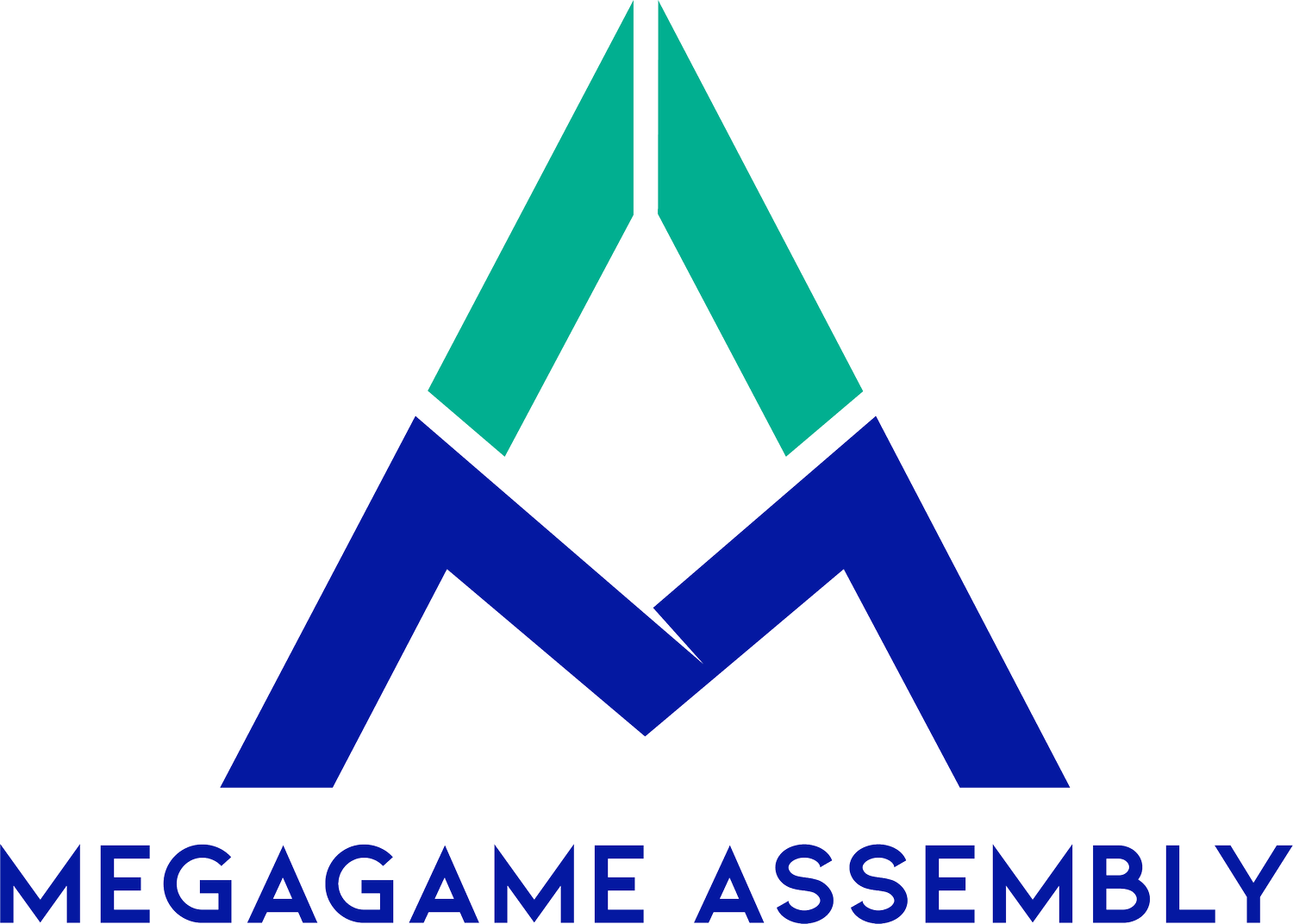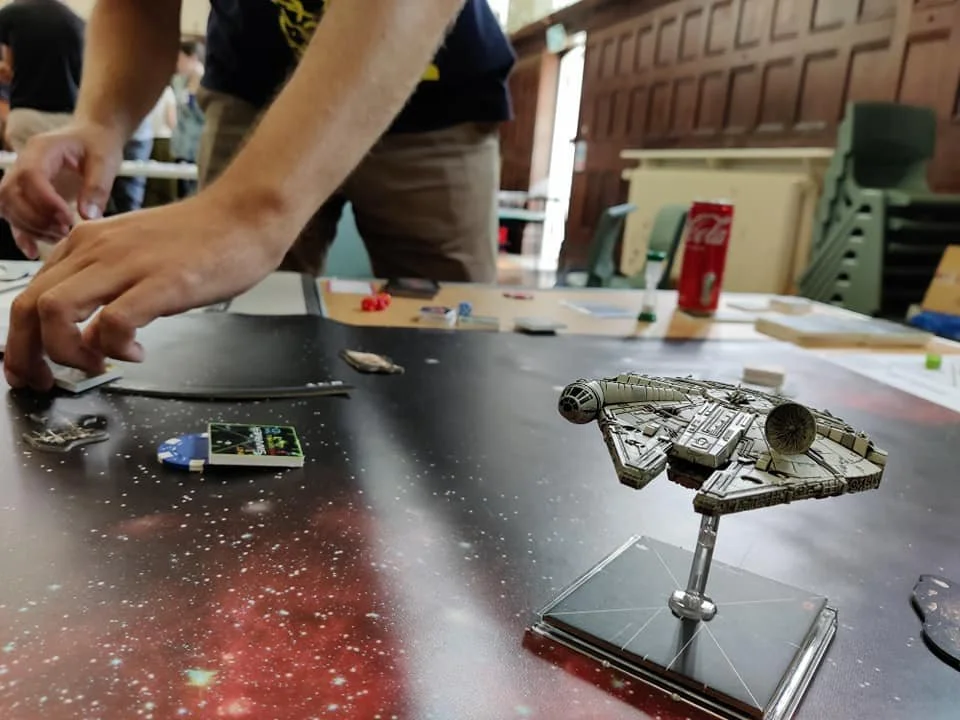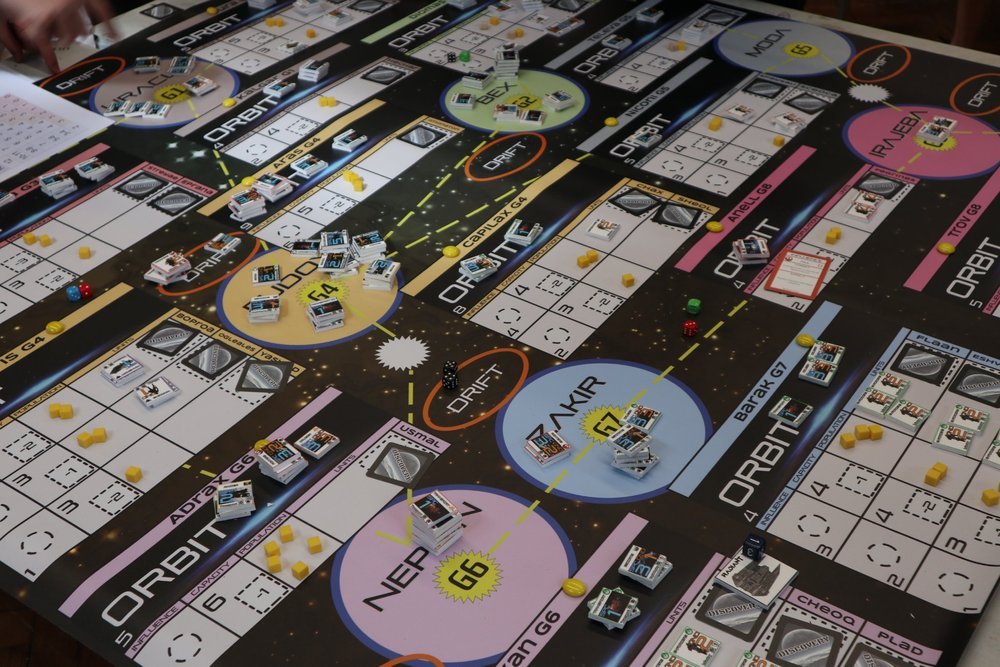Megagame Designer Thoughts: Starships & Six Shooters
A starship on its mission. Credit: Zane Gunton
In these articles, Rob Grayston chats with designers after their games have run, to talk a bit about their experiences, thoughts, and any general pearls of wisdom they may wish to impart. In this post, Rob spoke to Ben Hirsh, the designer of Starships & Six Shooters.
Want to talk to Rob about a game you’ve run recently? Get in touch now!
Ben, tell us a bit about yourself – how did you get into megagames?
By trade I’m a video game developer but I’ve often created games for reasons other than entertainment. They call them “serious” games, and I create medical games for a medical tech company (producing tools for people who have suffered strokes as an aid to physiotherapy), but don’t get me wrong I love regular games.
I’m a massive board gamer, which is how I got into megagames – I checked out the Shut Up and Sit Down video with a friend and so we went to a Watch the Skies in Brighton and it kicked off from there. I’ve been a fairly casual megagamer – couple of games a year, so it might seem odd I designed a whole game, but I do enjoy it.
How do you think your recent playthrough of Starships & Six Shooters went?
I think it went quite well, with a few glaring issues regarding some briefings for factions. Of the eight factions, I think between two and four of them could be improved along with a couple of their mechanics which could have been more fleshed out. Overall the core was quite solid and everyone seemed really engaged. No crashing and burning so I’m quite happy with it!
Megagames need drive and enthusiasm from a designer – what excited you about creating Starships & Six Shooters?
Having played a few megagames, I had thoughts around “this is how I’d do it instead” for some gameplay, and thought there was an opportunity or a niche with me doing that. I’ve always wanted to design a boardgame, but this is my first personal project I’ve finished, and for me the very attractive thing about megagames is that all you need to rely on here is people turning up! You don’t have to rely on supply chain or getting things printed in bulk in China or needing lots of cash to start it up compared to a boardgame.
Ben speaking at the introductory briefing. Credit: Michael Farfan
Related to this, what were your main influences when creating the game?
There were two main inspirations for this megagame; Blood and Thunder 4 (a big pirate game), where half the ship’s crew didn’t turn up. These pirate ship crews were split into sailing, navigation, etc., but having none of the sailing team turn up made my role more enjoyable as I’m not sure there would have been enough to keep a whole team engaged.
Also, up to this point megagames had been maps and political situations, but Blood and Thunder was more of an adventure, like a pirate simulation. This made me realise games don’t have to just be maps and politics, but also adventures and immersive experiences…then the other main influence; I’d been watching Firefly at the time, and I liked the idea of a character choosing a ship, getting on it, and going somewhere, and I really liked the idea of people choosing a ship rather than its destination. The design has changed over the years, but it’s kept some of these ideas from Blood and Thunder.
Players have a habit of doing unexpected things – from your recent run of the game, did anyone do something you hadn’t considered, and how did that go?
You may find this quite surprising, but I did not expect every ship in the game would join in on an attack on the Coalition Freedom Sphere*, but in hindsight it seems obvious. I thought some people might have not joined in and helped the Coalition, but they were much less interested in attacking each other – and then it worked really well! I should have expected it, and it worked out just fine.
I wish there had been a bit more unexpected stuff, perhaps because it’s a tad more of a mechanical game which is something I’ve seen feedback on, and this limited time for people to plot and come up with ideas.
I actually tried to orchestrate one of the ships siding with the Coalition and shooting another ship in the back, but every member of that ship mutinied against their captain when I did that! Maybe the lesson there is to try not to manipulate what the players are already doing?
For your next run of the game, what do you think you would amend, remove, or add?
Inspiration from Firefly and jumping onto different teams/ships was something I’ve seen in Mirrorshades and I love the idea of moving between teams, but as a designer I may have to let it go. There’s a cohesion and a relationship players have within a team, and it might not be so fun for players going off into another team, or losing people from your team, so I may remove player movement between ships. Also, there were some briefed subplots that were fun in theory but I may cut as players were less interested in who was on what ship and just wanted to hang out with their friends.
I would also put more focus on ships attacking each other, one of the cool ideas at the after-game pub session was the possibility of putting a big table in the middle of the venue for multiple starships, like an “arena” – and maybe make miniature ship dashboards so people can move around with better forms of interaction. Several players also mentioned a lack of global awareness in general around what was happening in the rest of the game. I didn’t think press would fit, but making announcements to the rest of the room might give a better sense of the game world, and what’s happening, so I think that will be included next time.
Two factions’ mechanics could have been more fleshed out, to help make organised crime more influential and annoying to deal with (with money getting taken through extortion etc.), and corporation briefings should be more obvious. I had planned to do a game strategy guide which would explain relationship dynamics that would give people more of a signpost on who should talk to who.
Lastly, the starships have action cards that can affect the faction game. These action cards that affected things were cool, but they could have been a bit more mechanically weightier and played a bigger part for the starship players.
Definitely lastly, tea and coffee! Lots of people wanted it, which should have been obvious, but it wasn’t provided.
A shot of the wider sector map. Credit: Alex Beck
What do you think would help new megagame designers in terms of resources and encouragement to create new games?
Resource-wise there’s a piece of software called nanDECK which is used by boardgame designers, and it is incredible! You basically feed a spreadsheet into it, and from this you can program the layout of your cards and tokens, etc. and it helps format them for you so you can send the files directly to the printer.
The guy that created this free tool is quick on the ball to amend bugs, and there’s support on the BoardGamesGeek forums. I normally find designing cards quite daunting, but this is altering things in one place and it has been amazing. Good software takes a lot of the edge off.
For encouragement – talk to people all the time; I’d get an injection of creativity when I shared stuff with people, which I know isn’t what everyone likes but this really helped me. There were some megagames I only attended to get the energy boost to work on my game!
Now that you’ve got one game under your belt, do you have any ideas for another megagame you’d like to develop further?
Apart from doing a 2.0 of Starships and Six Shooters, I have a couple of ideas – I want to do a Lord of the Rings one! But I do think the problem with something like that or another big intellectual property, is that you have to copy the exact theme; at least with Starships and Six Shooters it was a more general theme (some of you are the rebels, some are the big evil space empire, etc). War of the Ring looks like it would lend itself brilliantly to a megagame and it looks like it would lend itself to a game.**
A second idea would be Attack on Titan – you have a political layer, different stages of threat, and it can be cooperative but there’s also intrigue between teams. It could be a bit like a non-spaceship Den of Wolves? You can introduce all sorts to it, like switching it up with Cthulhu Mythos elements or similar.
If resources and time were no object, what would be your dream megagame to design?
So a little bit of game inspiration came from Artemis Spaceship Bridge Simulator, and I totally think there’s room for more technology in megagames. If you put in the work, and it would be a lot of work, to digitise all aspects of a game that might be used for a big setting over multiple rooms in the same venue where you could run something like a Star Trek megagame and you’re not just playing a single starship game by itself, but a bit of the wider galaxy – perhaps you go to another room if you’ve landed on a planet or boarded another ship, and more beyond that in terms of ideas.
For Starships and Six Shooters, if it was more digitised and players had giant tablets that allowed them to move units by touch, it might help remove the need for so many people as control, and with running things quickly.
I know some people have a problem with going digital, and although I know there’s a tactile element for people with components (like a handful of coins or a load of action cards), a digital game could create something new and exciting which is more scalable and accessible. Learning new rules for a game can be a barrier to entry, but with tech it can introduce people straight away as they get straight into pushing buttons, but perhaps it would be less engaging? Then again, a really rules-lite game that’s wholly automated might not have enough to hold people’s attention – but I’d love to go digital!
Players engaging with one of the starship maps. Credit: Zane Gunton
For anyone looking at designing a megagame, what is your one top tip for them?
There’s not one, let’s be honest – I made so many mistakes! I guess it depends on what stage people are during a megagame design, but if it’s at the very start, just talk to someone and get a date in the diary – having a deadline really helps focusing the mind. It really helped me having a date in the diary to work towards; these things are side projects for most of us, so they can get put aside and sort of ignored unless you had a day it needs to be done by.
But as well as this, obviously test, test, test! It may be harder to test it all, but test what you can so there’s something to lean on when other parts do fall over in your game.
Thanks Ben for letting us talk to you after your cool first game! His game ran with Horizon Megagames and we’re sure they’d pass any messages on to Ben if you contact them.
Designed and run a megagame that you’d like to talk to Rob about? Get in touch and we can facilitate your words appearing here!
*For legal reasons this is nothing like any other intellectual property’s moon-like superweapon.
**There has previously been at least one Middle-Earth based megagame, “For the Light of the Trees” by Andrew Hadley in 2007.




